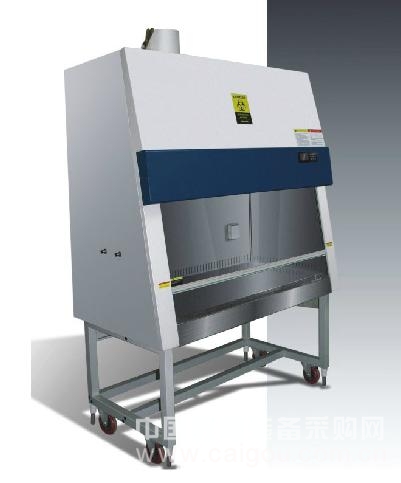
Shanghai Xinzhuang Instrument Co., Ltd. is committed to a business philosophy centered around technological innovation, continuously contributing to the development of human society through strategic and product innovations. As an integrated company that combines R&D, manufacturing, and sales, we take pride in delivering high-quality products and exceptional service. We welcome any inquiries from our customers.
Biological safety cabinets are primarily used for handling pathogenic bacteria, mold, and yeast. The operating area maintains a negative pressure environment, meaning air is constantly being exhausted. However, pathogens are not directly released into the external environment; instead, they are filtered through the top leakage device. These cabinets can be categorized into 50% outflow, 75% outflow, and 100% outflow types.
On the other hand, an ultra-clean workbench is designed for experiments involving non-harmful bacteria. It uses positive airflow, where the air is filtered before reaching the sample and the operator, ensuring a local cleanliness level of 100. Essentially, a clean bench functions like a smaller sterile room.
The key difference between a biosafety cabinet and a clean bench lies in their purpose and protection levels. A biosafety cabinet is used to protect both the operator and the environment when working with infectious materials such as cultures, bacterial strains, or diagnostic samples. It prevents exposure to harmful aerosols and spills during these procedures.
According to the WHO Laboratory Biosafety Handbook, biosafety cabinets significantly reduce the risk of laboratory infections and cross-contamination caused by aerosol exposure. They also help protect the surrounding environment from contamination. In essence, biosafety cabinets focus on safeguarding the operator, the environment, and preventing the spread of dangerous microorganisms that could cause harm.
Biosafety cabinets are classified into three levels based on the degree of protection they provide. A Class I biosafety cabinet protects the operator and the environment but not the sample itself. Its airflow system is similar to a fume hood, with a HEPA filter at the exhaust port to prevent microbial contamination. However, it lacks an internal fan and relies on external ventilation systems, making it less commonly used today.
Class II biosafety cabinets are the most widely used type. According to the Chinese pharmaceutical standard YY0569-2005, they are divided into four subtypes: A1, A2, B1, and B2. All Class II cabinets offer protection to the operator, the environment, and the samples inside the cabinet.
Ultra-clean workbenches, on the other hand, are known for their ease of use, efficiency, and quick preparation time. They operate using vertical or horizontal laminar airflow, creating a localized clean air environment ideal for scientific research, pharmaceuticals, medical equipment, and electronics. They are particularly useful in factory settings where long hours of work are required.
These benches are powered by a three-phase motor, consuming about 145–260W. Air is blown through a "super filter" made of special microporous foam sheets, producing a continuous flow of dust-free, sterile air. This air removes particles larger than 0.3μm, including dust, fungi, and bacterial spores. The airflow speed ranges from 24 to 30 m/min, sufficient to prevent nearby air contamination without interfering with the use of alcohol lamps or Bunsen burners.
Operators work under these sterile conditions to ensure that materials remain uncontaminated during transfer and inoculation processes. However, in the event of a power outage, materials exposed to unfiltered air may become contaminated. In such cases, it’s best to stop the operation immediately, label the containers, and decide whether to discard or continue the process based on the stage of the material.
At Shanghai Xinzhuang Instrument Co., Ltd., we are always ready to assist you. Our professional team will guide you through the details and help you choose the right equipment for your needs. Feel free to reach out for more information or support.
Material: Ceramic orchid pots are typically crafted from clay-based materials that are fired at high temperatures to achieve durability and strength. They can vary in texture, from smooth and glossy to rough and matte, depending on the specific ceramic composition and finish.
Design: These pots often feature a wider base and narrower opening, providing stability for the orchid plant while allowing for proper aeration and drainage. The design may include decorative elements such as embossed patterns, painted motifs, or textured surfaces, enhancing the aesthetic appeal of the pot.
Size: Ceramic orchid pots come in a range of sizes to accommodate different orchid species and growth stages. They can vary from small pots suitable for single orchid plants to larger containers capable of holding multiple plants or larger root systems.
Color: The color of ceramic orchid pots can vary widely, offering options to complement various orchid flower colors and interior or outdoor décor themes. Common colors include white, beige, terracotta, green, blue, and various shades of earth tones.
Drainage Holes: Proper drainage is crucial for orchid health, and ceramic orchid pots typically feature multiple drainage holes at the bottom to prevent waterlogging and root rot. These holes allow excess water to escape freely while providing adequate aeration to the orchid roots.
Saucer or Tray: Some ceramic orchid pots come with matching saucers or trays to catch excess water drainage, protecting surfaces from moisture damage and providing a tidy appearance.
Insulation: Ceramic pots offer some insulation against temperature fluctuations, which can be beneficial for orchids, helping to maintain stable root temperatures in varying environmental conditions.
Longevity: Ceramic orchid pots are known for their durability and can last for many years with proper care. They are resistant to fading, cracking, and weathering, making them a reliable choice for long-term orchid cultivation.
Overall, ceramic orchid pots blend functionality with aesthetics, providing a stylish and practical solution for growing orchids indoors or outdoors while enhancing the beauty of the plants they contain.
Orchid Pot, Ceramic Orchid Pot, Glazed Orchid pot
Yixing Bocai Pottery Co.,Ltd , https://www.bocaipottery.com